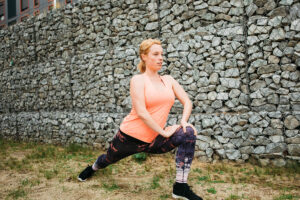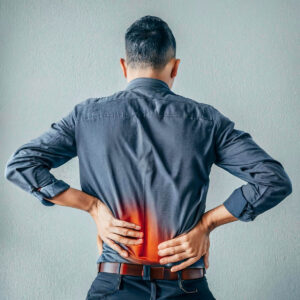Many people believe that stretching is important to maintain motion, prevent muscle soreness, prevent injuries, and alleviate pain. Have you ever heard someone say, “I tweaked ___. I must not have stretched enough beforehand.” As physical therapists, we are frequently asked questions about stretching . “Should I stretch before or after exercise?” “I stretch all the time, but my muscles still feel tight and I have lots of “knots” – why is that?” “How do I best stretch [blank]?”
Two important questions to consider are: 1) What is the purpose of stretching and 2) what is causing the muscle to be “tight”?
Three important things to note before diving into the topic of stretching are: 1) most stiffness is a sensation or symptom; 2) even hypermobile (really flexible) people can feel “stiff”; 3) stretching should never be painful. As Paul Ingraham states, “It’s important to keep in mind that there are true anatomical restrictions to stretching that include both general and individual limitations.” If one is stretching to the point of pain, they should give heed to the fact that it’s possible they are actually causing damage to muscle, tendon, ligament, or nerve.
If someone is stretching because they think it feels good to stretch, it helps them relax, or it is good for their mental health, then by all means they should stretch in a comfortable range. Problems arise when someone is stretching because they think it will help lengthen their muscles, prevent muscle soreness, prevent injury, or resolve their pain. Konrad et al found that stretching did not cause any structural changes and that perceived increase in range of motion is rather adaptations to nociceptive nerve endings, meaning that the tolerance to the stretch was increased rather than an increase in length. In a systematic review, Herbert et al found that there was no evidence to support stretching as an effective means to prevent muscle soreness. Pope et al performed a randomized controlled trial involving 1538 male army recruits and found that a muscle stretching protocol performed during pre-exercise warm-ups had no clinically meaningful reduction in risk of lower extremity exercise-related injury. Stretching does not address the root cause of symptoms, so if you are looking for the cure, it’s not stretching.
A truly tight muscle is synonymous with a short muscle. Whenever there is a muscle imbalance, the strong/dominant muscle becomes short and the weak muscle becomes lengthened. One can get the urge to stretch a lengthened muscle just as much as a short muscle. When a muscle is lengthened, there is minimal overlap and fewer actin/myosin chemical bonds supporting the muscle. The reduced overlap can cause the muscle to feel “stiff”. This is similar to if you were trying to save someone from falling off a cliff and were holding them by their fingertips, compared to holding each other’s forearms.
Muscle imbalances often result from underlying faulty movement patterns. If one solely stretches a muscle but does not address the underlying movement impairment, stretching will only have a temporary effect. It has been found that the immediate reduction in musculotendinous stiffness following 4, 8, or 30 minutes of stretching only lasts up to 10, 20, or 30 minutes respectively. There has not yet been determined a duration of stretching that can produce a lasting decrease in musculotendinous stiffness. Willy et al found that after a 6-week stretching regimen there was no retention of increased range of motion and return to baseline after 4-week cessation period. Youdas et al illustrates another example where a six-week stretching program once per day was not enough to increase active ankle dorsiflexion range of motion in healthy subjects. In order to truly address a “stiff” muscle, one must correct the faulty movement pattern and strengthen what is weak so that the “stiff” muscle, whether lengthened or short, can relax.
Are you tired of stretching diligently with no pay off? Are you interested in getting to the root of your pain? Here at Austin Manual Therapy Associates, our highly trained physical therapists will identify the underlying cause of your pain and what’s causing those pesky “tight” muscles and work with you to address your symptoms at the source. So why wait any longer? Schedule your appointment today and begin the journey to addressing your symptoms with purpose.
Julia Lapo, PT, DPT
Sources:
- Paul Ingraham. “Quite a Stretch: Stretching Hype Debunked.” Www.PainScience.com, https://www.painscience.com/articles/stretching.php#table_of_contents.
- Konrad A, Tilp M. Increased range of motion after static stretching is not due to changes in muscle and tendon structures. Clin Biomech (Bristol, Avon). 2014 May 9.
- Herbert RD, Gabriel M. Effects of stretching before and after exercising on muscle soreness and risk of injury: systematic review. BMJ. 2002 Aug;325(7362):468.
- Pope RP, Herbert RD, Kirwan JD, et al. A randomized trial of preexercise stretching for prevention of lower-limb injury. Medicine Science in Sports Exercise. 2000 Feb;32(2):271–7.
- Ryan, Eric D., et al. “The Time Course of Musculotendinous Stiffness Responses Following Different Durations of Passive Stretching.” Journal of Orthopaedic & Sports Physical Therapy, vol. 38, no. 10, 2008, pp. 632–639., doi:10.2519/jospt.2008.2843.
- Fowels JR, Sale DG, MacDougall JD. Reduced strength after passive stretch of the human plantarflexors. J Appl Physiol. 2000;89:1179-1188
- Willy, Richard W., et al. “Effect of Cessation and Resumption of Static Hamstring Muscle Stretching on Joint Range of Motion.” Journal of Orthopaedic & Sports Physical Therapy, vol. 31, no. 3, 2001, pp. 138–144., doi:10.2519/jospt.2001.31.3.138.
- 8. Youdas, James W., et al. “The Effect of Static Stretching of the Calf Muscle-Tendon Unit on Active Ankle Dorsiflexion Range of Motion.” Journal of Orthopaedic & Sports Physical Therapy, vol. 33, no. 7, 2003, pp. 408–417., doi:10.2519/jospt.2003.33.7.408.






